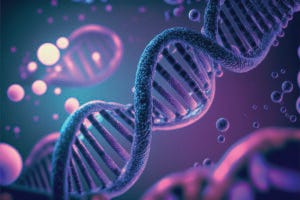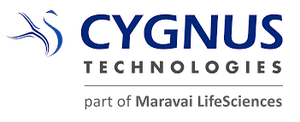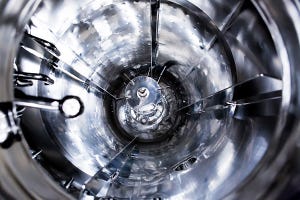
DNA Synthesis: Chemical, Enzymatic, or Both?DNA Synthesis: Chemical, Enzymatic, or Both?
Although chemical synthesis enables production of modified DNA products at manufacturing scales that cannot be achieved using enzymatic technology, the latter offers benefits related to sustainability and flexibility. Enzymatic synthesis should be able to make longer sequences than can be made through using chemical methods. Biological synthesis has been used for many years to obtain micrograms to kilograms of nucleic acids (e.g., of double-stranded circular DNA plasmids). Methods based on phage systems can make linear and circular single-stranded DNA in bacterial fermentation. For applications requiring large amounts of unmodified DNA, that approach could be both efficient and cost-effective. As the chief scientific officer of genomics company Integrated DNA Technologies points out in this brief discussion, quality control is important no matter what method of production is used.
October 20, 2023

DNA, the blueprint of life, has become a critical tool used in research, drug discovery, clinical diagnostics, and some therapeutics. Artificially synthesized sequences of DNA have long been used in molecular biology for a litany of techniques including polymerase chain reaction (PCR), cloning, DNA sequencing, and numerous assays that detect gene expression. Scientists discover new uses daily in areas such as clustered regularly interspaced short palindromic repeats (CRISPR) gene editing and synthetic biology. Such uses include making new genes, developing antisense drugs, and even storing data (1).
Researchers use two main synthesis methods to make DNA for the aforementioned applications: chemical and enzymatic. Chemical synthesis consists of building a DNA sequence one base at a time in the 3′ to 5′ direction. Starting from a solid support that anchors the first 3′-base of a nascent DNA sequence, phosphoramidite monomers are added sequentially. A phosphoramidite is a nucleotide that has protecting groups attached to its hydroxyl, phosphite, and primary amines. Those groups ensure that only a desired product is made by preventing unwanted side reactions that could lead to chain branching. Four sequential chemical steps must occur to complete the addition of each phosphoramidite base: deprotection (detritylation), coupling, capping, and stabilization.
Deprotection removes the protecting group from the 5′-hydroxyl of a nucleotide, after which it can react with incoming phosphoramidite nucleotide during the coupling step. After coupling, molecules that failed to extend are capped with an acetylating agent, preventing them from continuing to synthesize. Finally, the phosphite link between a nascent sequence and a new nucleotide is stabilized using oxidation. The DNA chain continues to grow using the four-step cycle until synthesis is complete, upon which the sequence is cleaved from its solid support. The remaining base-protecting groups are removed, leaving a final desired oligonucleotide (oligo) sequence.
Enzymatic Synthesis — Fulfilling Its Potential
In living cells, most DNA synthesis depends on DNA polymerase enzymes. Synthesis requires a templated nucleic-acid sequence to direct the order of base additions, resulting in the formation of a double-stranded final product. However, in a laboratory, a variant of enzymatic synthesis can be used with the enzyme terminal deoxynucleotidyl transferase (TdT). TdT can build DNA in the 5′ to 3′ direction without a template. TdT is an enzyme that naturally functions within T cells and B cells, adding random bases to DNA sequences for increased diversity in antibodies and T-cell receptors that are then selected for antigen affinity, which is an essential part of immune response maturation (2). Enzymatic synthesis makes use of the natural ability of this enzyme to add nucleotides to DNA sequences in a single-stranded fashion to manufacture synthetic single-stranded DNA. This synthesis method is under intense study and development because it theoretically has the ability to synthesize long DNA sequences (2). It is also a “greener” synthesis method; enzymes make synthetic DNA in aqueous solutions instead of using the organic chemicals needed for chemical synthesis.
Although enzymatic synthesis is a cleaner method with the potential to create longer nucleotide sequences, numerous issues limit its widespread use currently. A key concern is the burden to synthesize the wide spectrum of modified DNA molecules that are used commonly in modern molecular-biology methods. TdT must be mutated or engineered to accept the nonnatural base variants that comprise the repertoire of modifications needed. Many oligos that are used today are not simple sequences of plain DNA — they incorporate chemical modifications such as fluorophores, chemical linkers, variant bases, and phosphorothioate bonds that enable different engineered functionalities. Such modifications are essential for the sequences to function in their intended applications (3).
Although TdT can be developed to accept modified nucleotides as a substrate building block, doing so could require parallel development of a suite of enzymes that together can function with the variety of modified bases or nonbase groups in use today. There often is a tradeoff between mutating an enzyme to accept a new, modified substrate and retaining activity to work efficiently with unmodified DNA bases (4).
Scientists use chemical synthesis to manufacture DNAs with yields ranging from <1 μg to >1 kg. Those methods are highly optimized and have been used for over 40 years. Enzymatic-synthesis techniques are relatively young and less advanced. Current methods do not enable large-scale synthesis and are slow and expensive compared with chemical synthesis. However, as this technology matures, scientists anticipate that such drawbacks will be solved.
One product purity problem might be difficult to address. Unlike chemical synthesis, enzymatic DNA synthesis currently does not incorporate a capping step that blocks extension of failed reaction products. Such molecules continue to react and grow during subsequent steps, leading to an accumulation of failed products that are too long and contain many different deletion mutations (5). Long failed products can be difficult to separate from desired full-length products. In chemical synthesis, capped failure products are short and are easily purified from final nucleic acids.
Both Approaches, for a Greener Future
Although chemical synthesis enables scientists to make a wide range of modified products at scales that cannot be achieved using enzymatic approaches, there are clear advantages to enzymatic synthesis. Unlike chemical synthesis, enzymatic processes use nontoxic aqueous reagents, so no hazardous organic waste accumulates during manufacturing. Hence, high-throughput chemical synthesis ideally is performed at large, centralized plants built to handle organic waste, which must be disposed in a safe and environmentally sound way. That limits the geographic locations where chemical synthesis can occur, whereas enzymatic synthesis can be done anywhere, including on benchtops within individual research laboratories (6).
Enzymatic synthesis of unmodified oligos (or with a few, limited modifications) can be done onsite using available technology, albeit without product quality control (QC) testing. One advantage of performing synthesis at large, centralized facilities is the ability to couple synthesis with an extensive analytical suite where product QC is performed during manufacturing before material is released. Common QC technologies include mass spectrometry (MS) to assess compound identity and capillary electrophoresis (CE) or high-performance liquid chromatography (HPLC) to assess compound purity. Local sites, such as those that make oligos on a benchtop synthesis platform, rarely have access to a suite of costly QC tools. Newly synthesized enzymatic oligos are thus used based on the “faith” that they are correct — and, as anyone who has worked in manufacturing knows, this is not always the case. Synthesis failures occur, necessitating QC testing. Enzymatic synthesis is theoretically capable of manufacturing sequences longer than can be made using chemical methods — a clear potential advantage. As enzymatic methods improve, it is likely that such features will become increasingly important.
Biological synthesis, such as production of double-stranded circular DNA plasmids, has been used for many years to obtain micrograms to kilograms of nucleic acids. This method can yield research-use only (RUO) products or even current good manufacturing practice (CGMP) materials for medical use. Methods based on phage systems can even manufacture single-stranded DNA using bacterial fermentation, yielding linear or circular end-products (7). For applications requiring large amounts of unmodified DNA, this approach may prove to be efficient and cost-effective.
Given the different pros and cons of the two approaches to synthesis, it makes sense to exploit their complementary nature. Even though chemical synthesis is the only option today to make highly modified or large-scale oligonucleotides, enzymatic synthesis can be used in parallel to make small-scale unmodified oligos, or modified from a limited menu. The synthesis method therefore will differ depending upon the end product. Shifting to this paradigm reduces the waste and chemical burden of DNA synthesis compared with only using chemical methods. Ideally, future nucleic-acid synthesis facilities will support a hybrid model, enabling scientists to perform chemical, enzymatic, and maybe even biological synthesis.
References
1 Meiser LC, et al. Synthetic DNA Applications in Information Technology. Nat. Commun. 13(352) 2022; https://doi.org/10.1038/s41467-021-27846-9.
2 Eisentstein M. Enzymatic DNA Synthesis Enters New Phase. Nat. Biotechnol. 38, 2022: 1113–1115; https://doi.org/10.1038/s41587-020-0695-9.
3 Lennox KA, Behlke MA. A Direct Comparison of Anti-microRNA Oligonucleotide Potency. Pharm Res. 27, 1788–1799 2010; https://doi.org/10.1007/s11095-010-0156-0.
4 Ashley J, Potts IG, Olorunniji FJ. Applications of Terminal Deoxynucleotidyl Transferase Enzyme in Biotechnology. ChemBioChem 24(5) 2023; https://chemistry-europe.onlinelibrary.wiley.com/doi/10.1002/cbic.202200510.
5 Jensen MA, Davis RW. Template-Independent Enzymatic Oligonucleotide Synthesis (TiEOS): Its History, Prospects, and Challenges. Biochemistry 57(12) 2018: 1821–1832; https://pubs.acs.org/doi/10.1021/acs.biochem.7b00937.
6 Barthel S, et al. Enhancing Terminal Deoxynucleotidyl Transferase Activity on Substrates with 3′ Terminal Structures for Enzymatic De Novo DNA Synthesis. Genes. 11(1), 102, 2020; https://doi.org/10.3390/genes11010102.
7 Praetorius F, et al. Biotechnological Mass Production of DNA Origami. Nature. 552(1), 84, 2017; https://doi.org/10.1038/nature24650.
Mark Behlke, MD, PhD, is chief scientific officer at Integrated DNA Technologies, a global genomics solutions provider whose mission is to accelerate the pace of genomics. For inquiries contact Kristina Sarenas; [email protected].
You May Also Like




